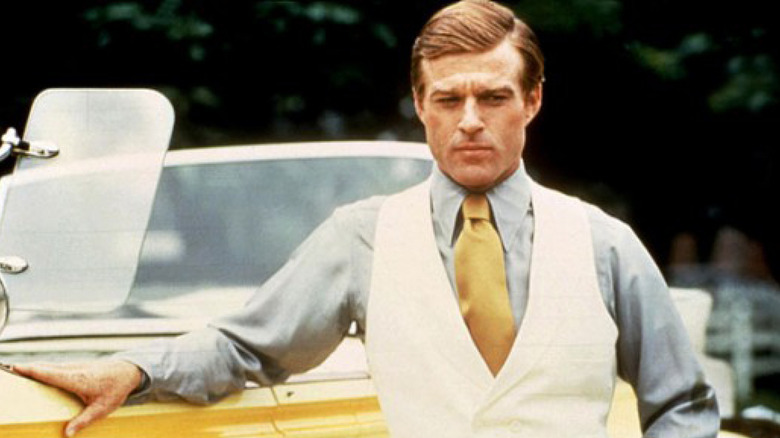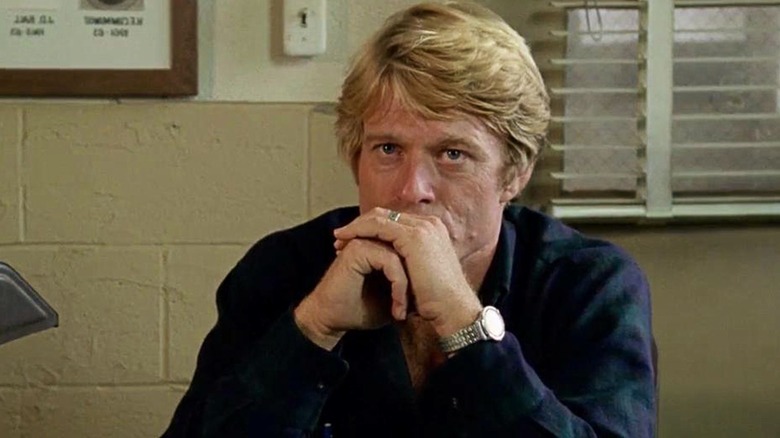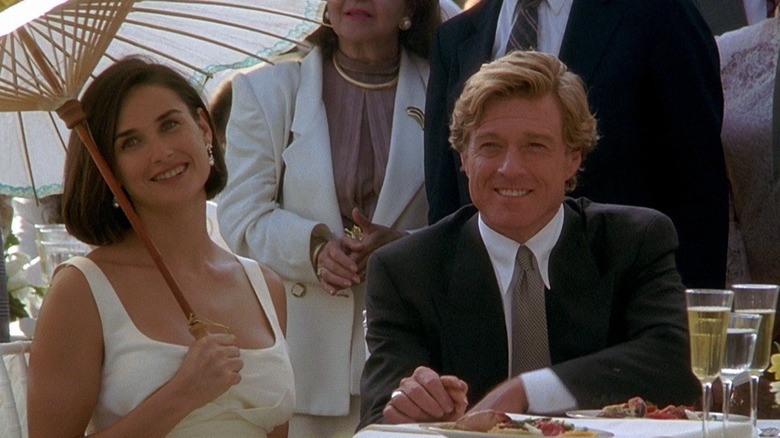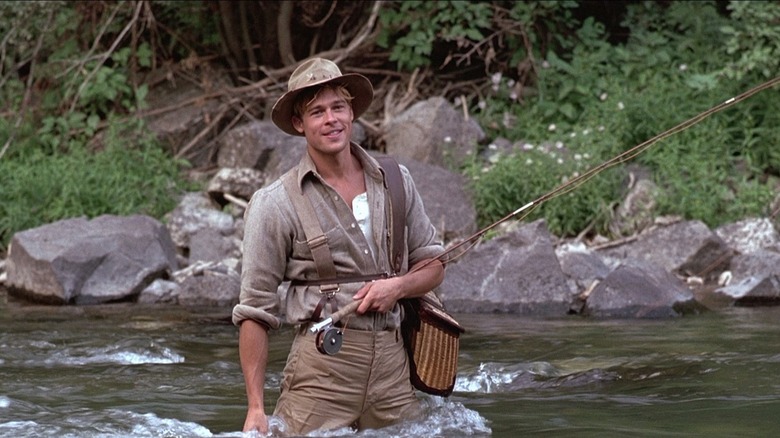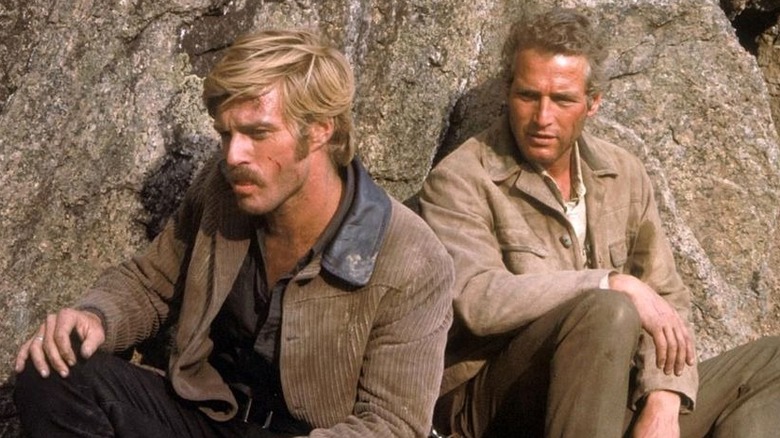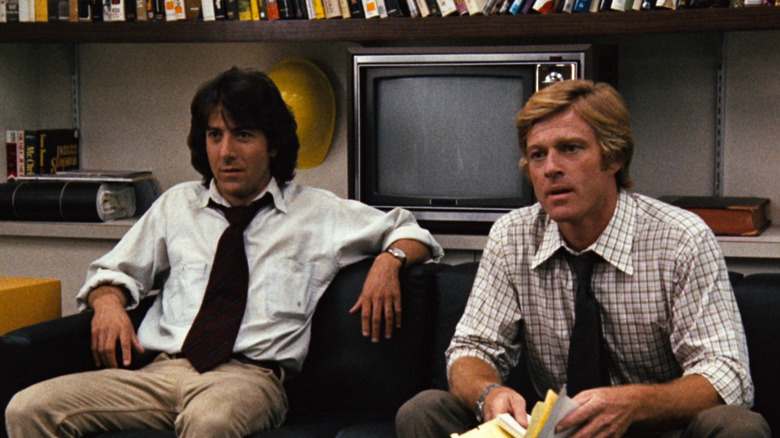Robert Redford's 15 Best Movies Ranked
Robert Redford, actor, director and co-founder of the Sundance Film Festival, is a living screen legend who has had an incredible 50-year movie career, lasting from his breakout role in "Barefoot in the Park" (1967) through what is said to be his final movie before retiring, "The Old Man and the Gun" (2018).
Redford was the biggest star of the '70s, which is when he had most of his best acting roles, before making his directorial debut in 1980. Redford often brought his political beliefs into his work and examined the heart of America by making period films that spanned every decade of the 20th century. From sports films to crime flicks to movies based on real people and events, Redford's legacy is a chronicle of the role of the American male through various political and social upheavals, but always with a sense of humanity always at its core. Counting both the films that he acted in and the ones that he directed, these are his best movies.
15. Ordinary People (1980)
"Ordinary People" was Redford's directorial debut (although he was heavily involved in the development of "All the President's Men") and would go on to win best picture at the Academy Awards. It stars Donald Sutherland and Mary Tyler Moore as Calvin and Beth Jarrett, a rich Chicago couple whose eldest son dies in an accident. Their younger son, Conrad (played by Timothy Hutton in his breakthrough role), has PTSD and survivor's guilt and attempts to take his own life. Judd Hirsch plays a psychiatrist who attempts to improve Conrad's strained relationship with his mother, who wants to keep up the appearances of a perfect family.
As is often the case when an actor turns director, the acting is what stands out in "Ordinary People," which was heavily praised for the performances. A suburban family drama that explores the cracks in a seemingly flawless façade, "Ordinary People" shows a family unravelling once they face up to how they're actually feeling, and explores the damage that comes from constantly pretending to live up to the image of the ideal American family as presented in the sitcoms of the '50s and '60s (a few of which Mary Tyler Moore starred in).
14. All is Lost (2014)
Stranded-at-sea movies are a niche but successful genre. They present a situation that is ripe for thrills and drama, whether the tension comes from passengers squabbling, such as in Hitchcock's "Lifeboat" (1944) or the documentary "Maiden" (2018), or people stuck alone and struggling to maintain their sanity, as with "Life of Pi" (2012) and "Adrift" (2018). J.C. Chandor's "All is Lost" is a one-man-show starring a 77-year-old Robert Redford in an almost entirely dialogue-free role.
It's a bold challenge (both physically and mentally) for Redford to take on at such a late stage in his career, but it is one that plays to his strengths. Redford has always excelled at silently reacting — his eyes seem to take in everything around him, and his often-tense mouth conveys disbelief or disapproval. We watch as Redford becomes increasingly exhausted and desperate on his damaged boat as one thing after another goes wrong, yet his will to survive remains strong. A small but mighty film that came at the perfect time for Redford, we are lucky to have this stand-out performance from one of our great actors.
13. The Great Gatsby (1974)
Most of us study "The Great Gatsby" in school, so therefore we all have an opinion on the casting of a character as iconic as Gatsby. While Redford was physically right for the role, I'm not sure if he had the right temperament for F. Scott Fitzgerald's mysterious millionaire. While several directors have capitalized on Redford's good looks, casting Redford in romantic roles for movies like "Barefoot in the Park" and "The Way We Were," he works better when he's the one being pursued, rather than playing the pursuer.
Mia Farrow as Daisy, on the other hand, is perfect casting, as is Karen Black as Myrtle. With Jack Clayton (director of "The Innocents") at the helm and a script by Francis Ford Coppola, "The Great Gatsby" is a strong adaptation that tries to give us more backstory for Gatsby and Daisy, and more of a reason to root for them. The '70s soft-focus perfectly suits the nebulous Gatsby and ethereal Daisy, with hazy pastels and billowing white drapes surrounding the lovers as they desperately attempt to fix the past. It's interesting to see Redford in a different kind of role, even if he does seem slightly like a square peg.
12. The Natural (1984)
One of the many period films Redford has made, "The Natural" is set between the '10s and '30s and tells the story of Roy Hobbs, a middle-aged man who comes from nowhere, joins an embattled baseball team as a rookie, and starts to turn their fortunes around with his prodigious talent. "The Natural" is based on a novel by Bernard Malamud and feels very Steinbeck-esque, with its commentary on the American dream and (sometimes heavy-handed) metaphorical elements.
The film is directed by Barry Levinson and co-stars Glenn Close as Hobbs' childhood sweetheart, who returns to him dressed in all-white as an angelic good luck charm, Kim Basinger as a temptress, and Barbara Hershey in an opaque role: a woman dressed in a black mourning veil who is on some kind of crusade against elite athletes. Baseball films like "A Field of Dreams" and "A League of their Own" often take on a mythic and ethereal quality, drenched in golden-hued nostalgia. "The Natural" is no exception, but Redford's role is one he can sink his teeth into.
11. Three Days of the Condor (1975)
"Three Days of the Condor" is a spy thriller directed by Sydney Pollack which is, hilariously, based on a book called "Six Days of the Condor" (where the other three days went is unclear). The first thing that has to be mentioned in any discussion of this film is Redford's wardrobe. He's never looked cooler than he does in this film. The gold-rimmed glasses, the mirrored aviators, the dark pea coat with the popped collar, the denim cowboy-style shirt, all of it topped off with a turquoise necklace — Redford's fits in this movie are legendary.
"Three Days of the Condor" starts with the massacre of all of Joe Turner's (Redford) colleagues, forcing him to go on the run and making him paranoid for the rest of the film's runtime. Turner ends up taking refuge in a stranger's apartment, but since the stranger is played by Faye Dunaway, it doesn't take long for Stockholm Syndrome to set in. Max von Sydow plays one of the villains. Like much of Redford's '70s work, "Three Days of the Condor" sees the actor playing a man who rails against a corrupt system, attempting to be a whistleblower who exposes the rot at the core of an institution. Joe Turner is a prototypical Redford protagonist who just happens to look exceedingly cool.
10. Brubaker (1980)
With prison reform and prison abolition being big topics of conversation in the last few years, Stuart Rosenberg's "Brubaker" feels ahead of its time. Redford plays the titular character, who goes undercover on a prison farm where the prisoners are used as slave labor for the profit of others. He then takes over the prison and attempts to make sweeping reforms, but is met with much opposition, drawing the ire of senators and governors.
Yaphet Kotto, Morgan Freeman, and Richard Ward have supporting roles, but "Brubaker" can understandably be viewed as a "white savior" movie. Redford brought his political views to many of his roles, including "The Candidate" and "All the President's Men," and "Brubaker" is no exception. With what we now know about mass incarceration and the prison industrial complex in the United States, "Brubaker" makes for an imperfect but interesting time capsule, as many of the issues it raises have unfortunately only gotten worse since it was released.
9. The Old Man & the Gun (2018)
David Lowery is currently wowing audiences with his twisted take on "The Green Knight." Before that, he directed Redford in what is said to be the actor's swan song, "The Old Man & the Gun." I will admit to having prejudged this film based on the title (perhaps because Eastwood's "The Mule" came out in the same year), but it was a refreshing surprise once I actually watched it.
Redford plays Forrest Tucker, a robber in 1981 who uses his age and unassuming charm to hold banks up, barely even having to show his gun. Casey Affleck plays the detective who pursues him, leading to a "Catch Me if You Can"-style relationship. Sissy Spacek appears as a widow who Tucker also charms, while Danny Glover and Tom Waits play fellow members of his gang.
If "The Old Man & the Gun" does end up being Redford's last role, it is a perfect send-off, and one we are fortunate that Redford chose. You can draw a direct through-line from Redford's '70s heist films like "The Hot Rock" and "The Sting" to "The Old Man & The Gun" — and that's the highest compliment I can give it. A slick and thoroughly entertaining ride that brings Redford all the way from the Sundance Kid's Hole-in-the-Wall Gang to the Over-the-Hill Gang, I really hope more people check this one out.
8. Indecent Proposal (1993)
Adrian Lyne is the king of erotic thrillers, and "Indecent Proposal" is one of the more romantic films in his oeuvre — even if the high concept does involve buying Demi Moore for one night for one million dollars. I mentioned earlier that Redford works better as a romantic lead when he's being pursued than doing the pursuing, but the manner in which he coolly and calmly propositions David (Woody Harrelson) and Diana (Moore) is so matter-of-fact that the seduction is a foregone conclusion. He knows that they will end up coming to him.
This is one of Redford's more interesting performances, as he manages to remain charming and sympathetic despite the shocking nature of what his character proposes. "Indecent Proposal" came at an especially fruitful time in Redford's career and was probably a payday to fund one of his passion projects. However, his performance does not feel phoned in. Moore and Redford are two beautiful, glamorous movie stars who sell a ridiculous concept through the sheer force of their star power, and it works.
7. The Way We Were (1973)
If you're anything like me, you've watched the clip of Barbra Streisand gently stroking Robert Redford's gorgeous locks and saying "Your girl is lovely, Hubbell" many times. But if you haven't actually seen the movie in question, it may have more communism and McCarthyism than you're expecting.
No still image, gif, or clip that you've seen from "The Way We Were" can prepare you for the fact that it's set between the '30s and the '50s, because it could not look more '70s if it tried. Two of the decade's biggest stars coming together for a sweeping romance was always going to be a big deal, but this really is Streisand's show — Katie is the force at the center of this whirlwind, while Redford's Hubbell reluctantly comes along for the ride.
Watching this mismatched couple try to make things work during a tumultuous period in history is compelling, even though you may start throwing things at the screen when they make certain decisions. The introduction of a baby at the end of the film is so much of an afterthought that even Hubbell seems to forget she exists, but minor quibbles aside, this epic romance is a must-watch and pairs well with "Barefoot in the Park."
6. A River Runs Through It (1992)
"Legends of the Fall" may have been the Brad Pitt-starring historical film from the early '90s that made most girls swoon, but "A River Runs Through It" was the movie that wore out my VCR. Much has been made of the physical similarities between Redford and Pitt, and their working together certainly had an inevitability to it (they would later share the screen in 2001's "Spy Game"). Here, Redford directs Pitt and Craig Sheffer as brothers vying for the affections of their strict father Reverend Maclean (Tom Skerritt), while their mother (Brenda Blethyn) tries to keep the peace.
Look, I can't beat around the bush, this is a film about fly fishing in Montana in the '10s and '20s, and the leisurely pace will not be to everybody's taste. Pitt's Paul Maclean does inject some life into the film as a rebellious reporter who clashes with his father, brother, and their community due to his drinking, gambling, and choice of girlfriend. "The Natural" would make a good double-bill with "A River Runs Through It" — they are set in similar eras, and the nostalgic love for their chosen sports (baseball and fishing, respectively) comes wafting off the screen. Redford certain has certain themes that he likes to return to.
5. Butch Cassidy and the Sundance Kid (1969)
"Jesus, who are those guys?" With a sharp-witted script by William Goldman, George Roy Hill's "Butch Cassidy and the Sundance Kid" may be the best western of all time. The central trio of Redford, Paul Newman, and Katharine Ross have an incredibly charming dynamic that sweeps you along on their adventures from Wyoming to Bolivia. Add in Burt Bacharach's music, especially the delightful "Raindrops Are Falling on My Head" sequence, and you have an endlessly rewatchable winner.
The 10-year age gap between Redford and Newman works perfectly, with the irony being that Butch has a much sunnier and optimistic outlook than the Sundance Kid. Of course, that name would go onto have a lasting legacy both for Redford and the wider film community with the birth of the Sundance Film Festival. Butch and Sundance are a great mix of adept and inept. Sundance is an expert sharpshooter and Butch is a good leader and great planner, but when faced with the "super posse," the pair realize they're outmatched. Butch using way too much dynamite to blow up a train carriage, and Sundance admitting he can't swim, are comedic highlights. This was Redford's breakout role, the one that would make him into the biggest star of the '70s. What an arrival it was.
4. Sneakers (1992)
"My voice is my passport. Verify me." With an impressive ensemble cast and a convoluted but ultimately satisfying plot, "Sneakers" is an enjoyable caper involving a black box, the NSA, and early-'90s computer tech with some Redfordian politics thrown in for good measure. The terrific cast includes Sidney Poitier, Dan Aykroyd, David Strathairn, and River Phoenix as Redford's team of hackers, Mary McDonnell as his ex-girlfriend, and Ben Kingsley as a shady figure from his past.
Like all of the best heist films, "Sneakers" is densely plotted, but the twists and turns are incredibly fun to discover. The camaraderie and banter between the team is perhaps its greatest strength, with many lines that become burned into the brain, including, "I leave message here on service but you do not call." This film is filled with puzzles and anagrams and lets the audience feel smart for keeping up, while the enemies are more complex than just "the Russians." The villain main has a surprisingly nihilistic goal for the time, too (he chooses chaos). The band of hackers are caught up in something they want nothing to do with, and we find ourselves very much rooting for them and their ramshackle way of trying to get out of it. There's a great dance party somewhere in there, too.
3. The Sting (1973)
Reuniting Redford with director George Roy Hill and co-star Paul Newman, "The Sting" is an unofficial follow-up to "Butch Cassidy," except with Newman taking the mustache instead of Redford. "The Sting" brings all of the pleasure of watching a long con unfold and withholds precisely enough information so that we can discover the twists and turns at the same time as the target, Doyle Lonnegan (Robert Shaw). Set during the '30s, there are also some fantastic suits, hats, and shoes to enjoy.
Long con movies are always massively entertaining, and while the audience likes to feel like they're in on the plan, viewers also enjoy having the rug pulled out from under them with big reveals. "The Sting" manages to do both. Redford and Newman's winning dynamic is perhaps even better here than in "Butch Cassidy," and Shaw makes a brilliant foe. "The Sting" is one of the best-ever best picture winners by virtue of the fact it is pure, unadulterated fun from start to finish.
2. Quiz Show (1994)
When I was around 13 or 14, I rented three films from my local video store so often that they gave me the movie posters: "A River Runs Through It," "Sneakers," and "Quiz Show." It wasn't until later that I realized that Robert Redford was the link between all three. "Quiz Show" is based on the true story of Charles Van Doren (Ralph Fiennes) and Herb Stempel (John Torturro), two contestants on the popular game show "Twenty-One."
Jewish Stempel, from Queens, has been on a winning streak for some time, but when his popularity wanes the show's producers decide that it's time for new blood — and Van Doren, a WASP-y Columbia professor is considered the perfect antidote. A disgruntled Stempel starts to claim that the show was fixed, and lawyer Richard Goodwin (Rob Morrow) investigates.
"Quiz Show" very much replicates "All the President's Men" in terms of making the investigation of a scandal absolutely riveting, even if the stakes are somewhat lower than the integrity of the commander in chief. The personalities are really what makes this film, plus the supporting work from Paul Schofield as Van Doren's father and Martin Scorsese (yes, really) as the sponsor of "Twenty-One," who calls many of the shots. "Twenty-One" is a fascinating glimpse into the grip television had on the US in the '50s and '60s — the glowing box in the living room was very much considered part of the family.
1. All the President's Men (1976)
President Richard Nixon resigned in August 1974 and less than two years later, Alan J. Pakula's "All the President's Men" was released, based on the book by Bob Woodward and Carl Bernstein. Redford, as producer, was key in getting the film made, recruiting "Butch Cassidy" screenwriter William Goldman to adapt Woodward and Bernstein's book. Editor Ben Bradlee (played by Jason Robards in the film) served as a consultant, and Redford and Dustin Hoffman spent some time at the Washington Post observing and sitting in on editorial meetings. The Post's vast newsroom, which forms the beating heart of the film, was meticulously recreated in a studio in Burbank.
Beyond the set design, the cinematography by Gordon Willis is probably the most breathtaking aspect of this masterpiece — the blocking, use of depth of field, and split diopters create an authentic, bustling office where the background is given equal weight with the foreground. Redford and Hoffman learned not only their own complicated dialogue, which had to be memorized so that long takes of phone calls could be recorded, but also each other's so that they could interrupt one another to increase the authenticity. "All the President's Men" is an utterly compelling look at how two young reporters brought down a president, and is eminently rewatchable.



